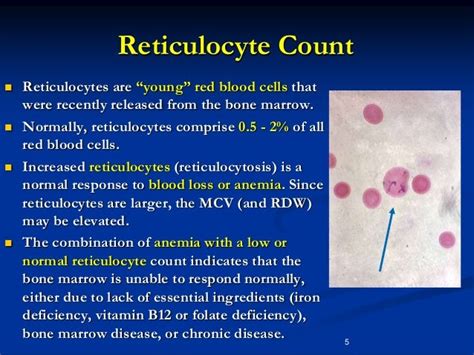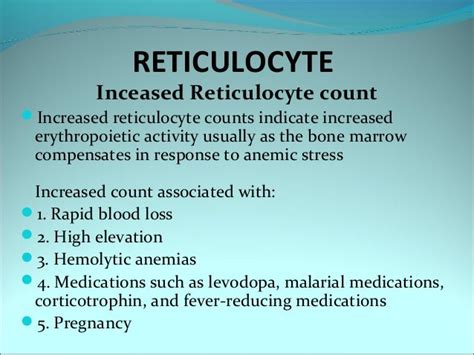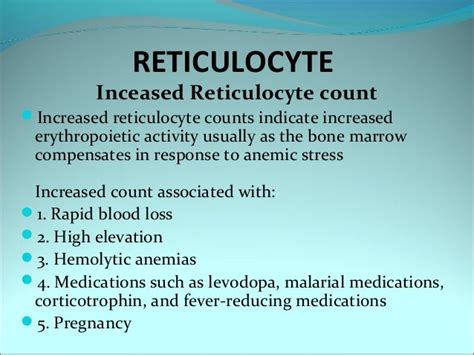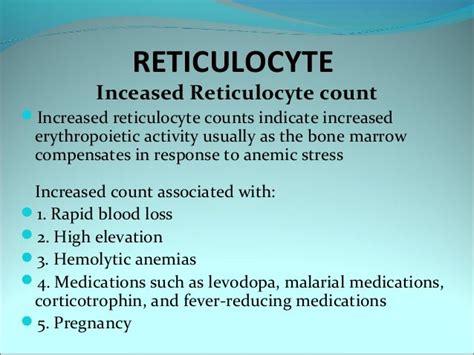Intro
Learn about high reticulocyte count, its causes, and implications. Discover how it relates to anemia, blood cell production, and bone marrow function, and understand the significance of reticulocyte tests in diagnosing underlying health conditions.
A high reticulocyte count is a medical condition that has garnered significant attention in recent years due to its implications on overall health and wellbeing. Reticulocytes are immature red blood cells that are produced in the bone marrow and play a crucial role in maintaining healthy blood cell counts. When the reticulocyte count is elevated, it can be an indication of an underlying condition that requires medical attention. In this article, we will delve into the world of high reticulocyte counts, exploring what they are, their causes, symptoms, diagnosis, and treatment options.
The importance of understanding high reticulocyte counts cannot be overstated. A high reticulocyte count can be a sign of a serious underlying condition, such as anemia, blood disorders, or bone marrow problems. It is essential to recognize the signs and symptoms of a high reticulocyte count to seek medical attention promptly. Furthermore, understanding the causes and treatment options for high reticulocyte counts can help individuals take proactive steps towards managing their condition and improving their overall health.
Reticulocytes are produced in the bone marrow and are released into the bloodstream, where they mature into red blood cells. A normal reticulocyte count is typically between 0.5% and 1.5% of the total red blood cell count. However, when the reticulocyte count exceeds this range, it can be an indication of an underlying condition. A high reticulocyte count can be caused by various factors, including anemia, blood loss, bone marrow disorders, and certain medications.
What is a High Reticulocyte Count?

Causes of High Reticulocyte Count
The causes of a high reticulocyte count can be diverse and varied. Some of the most common causes include: * Anemia: Anemia is a medical condition characterized by a low red blood cell count. When the body detects a low red blood cell count, it produces more reticulocytes to compensate for the loss. * Blood loss: Blood loss due to injury, surgery, or other medical conditions can lead to a high reticulocyte count. * Bone marrow disorders: Bone marrow disorders, such as leukemia or lymphoma, can affect the production of reticulocytes. * Certain medications: Certain medications, such as erythropoietin, can stimulate the production of reticulocytes.Symptoms of High Reticulocyte Count

Diagnosis of High Reticulocyte Count
The diagnosis of a high reticulocyte count typically involves a physical examination, medical history, and laboratory tests. Some common laboratory tests used to diagnose a high reticulocyte count include: * Complete blood count (CBC): A CBC is a blood test that measures the levels of different blood cells, including red blood cells, white blood cells, and platelets. * Reticulocyte count: A reticulocyte count is a blood test that measures the number of reticulocytes in the bloodstream. * Bone marrow biopsy: A bone marrow biopsy is a procedure that involves removing a sample of bone marrow tissue for examination.Treatment Options for High Reticulocyte Count

Complications of High Reticulocyte Count
The complications of a high reticulocyte count can be severe and varied. Some common complications include: * Anemia: Anemia can occur when the body does not have enough red blood cells to carry oxygen to the tissues. * Organ damage: Organ damage can occur when the body does not have enough red blood cells to carry oxygen to the organs. * Infections: Infections can occur when the body does not have enough white blood cells to fight off infections.Prevention of High Reticulocyte Count

Conclusion and Next Steps
In conclusion, a high reticulocyte count is a medical condition that requires prompt medical attention. Understanding the causes, symptoms, diagnosis, and treatment options for a high reticulocyte count can help individuals take proactive steps towards managing their condition and improving their overall health. If you or someone you know is experiencing symptoms of a high reticulocyte count, it is essential to seek medical attention promptly.We invite our readers to share their thoughts and experiences with high reticulocyte counts in the comments section below. Additionally, we encourage readers to share this article with others who may be interested in learning more about this topic. By working together, we can raise awareness and promote education about high reticulocyte counts and other related medical conditions.
What is a normal reticulocyte count?
+A normal reticulocyte count is typically between 0.5% and 1.5% of the total red blood cell count.
What are the symptoms of a high reticulocyte count?
+The symptoms of a high reticulocyte count can vary depending on the underlying cause, but common symptoms include fatigue, shortness of breath, pale skin, and headaches.
How is a high reticulocyte count diagnosed?
+A high reticulocyte count is typically diagnosed using a combination of physical examination, medical history, and laboratory tests, including a complete blood count (CBC) and reticulocyte count.
